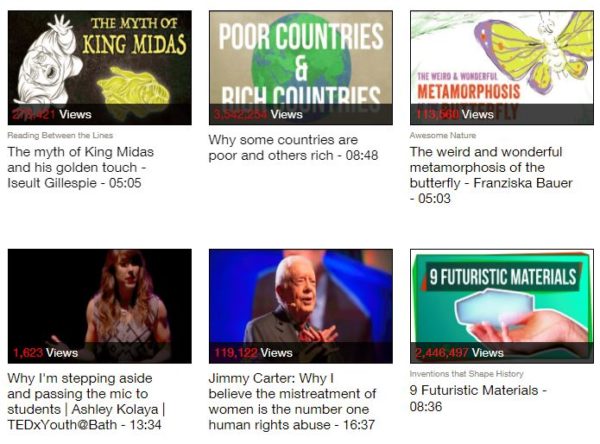Using digital media is a surefire way to grab students’ attention, and using everyday topics students encounter in their personal lives is an even better way to engage them in learning.
With a wealth of resources online, educators can find content that meets students where they’re comfortable learning, with interactive and engaging presentation. TED-Ed Lessons [1] are among the resources that help students learn while engaging them in the subject matter.
TED Talks have grown in popularity in part for their inspiring and frank perspectives on any number of world issues, and educators can leverage these resources for learning.
Educators can build lessons around any TED-Ed Original, TED Talk, or YouTube video through Ted-Ed. Once they locate the video they wish to use, they use the TED-Ed Lessons editor to add questions, discussion prompts, and additional resources. When the lesson is published, educators can monitor their progress and submitted work.
TED-Ed’s public lessons library offers customizable existing lessons for educators to use, as well.
(Next page: 8 TED-Ed Lessons that can engage students)
Here are 8 TED-Ed Lessons students might find engaging, thought-provoking, or funny:
1. Why some countries are poor and others rich [2]
The reason why some countries are rich and others poor depends on many things, from the quality of their institutions to what latitude they’re on. The School of Life helps to explain why some countries prosper and others stagnate.
2. 9 Futuristic Materials [3]
“Scotty, we need transparent aluminum now!” “But Jim, we don’t have the power or technology to do it!” That was 1986. It’s 2018, and we do now. This futuristic material in Star Trek IV came from a faraway future and 30 years later, that faraway future is our present reality. When we consider how the knowledge of chemistry, physics, design, and engineering are synthesizing, the future looks innovative, functional, and strong.
3. Why perfect grades don’t matter [4]
Most American students strive for a 4.0 GPA and the highest test scores, but research shows that this quest for perfection actually discourages creativity and reduces academic risk-taking. In this episode of “School Myths” by The Atlantic, Alice Roth investigates why grades aren’t everything when it comes to education.
4. Why you should define your fears instead of your goals [5]
The hard choices–what we most fear doing, asking, saying–are very often exactly what we need to do. How can we overcome self-paralysis and take action? Tim Ferriss encourages us to fully envision and write down our fears in detail, in a simple but powerful exercise he calls “fear-setting.”
5. What is the Internet of Things? [6]
The Internet of Things gives us access to the data from millions of devices. But how does it work, and what can we do with all that data? Find out in this animated tutorial from IBM’s Think Academy.
6. How long will human impacts last? [7]
Imagine aliens land on Earth a million years from now. What will these curious searchers find of us? They will find what geologists, scientists, and other experts are increasingly calling the Anthropocene, or new age of mankind. David Biello explains how the impacts that humans have made have become so pervasive, profound, and permanent that some geologists believe we merit our own epoch.
7. How a 15-year-old solved a Rubik’s Cube in 5.25 seconds [8]
Rubik’s Cube pro Collin Burns tells how he solved the cube in 5.25 seconds.
8. Should we get rid of standardized testing? [9]
Although standardized testing is a particularly hot topic in education right now, this approach to measurement has been in use for two millennia. And while the results of standardized testing can help us understand some things, they can also be misleading if used incorrectly. So what do these tests actually measure? And are they worthwhile? Arlo Kempf investigates.
